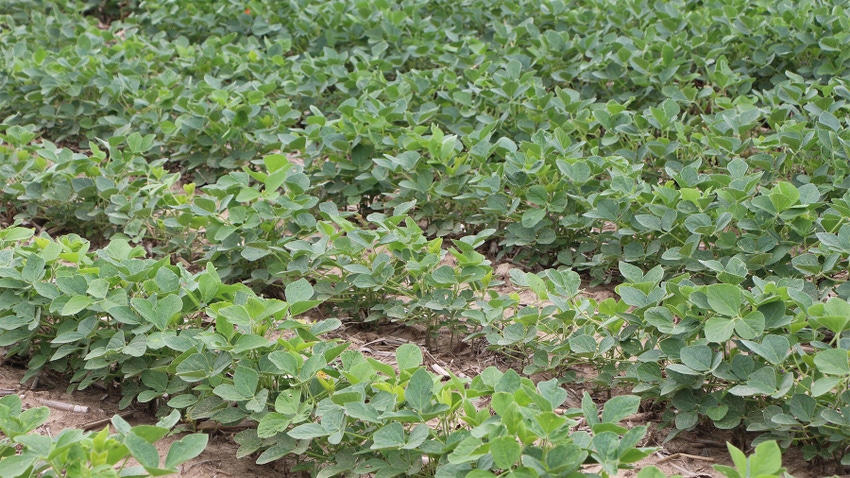
Herbicide carryover may be a problem for Missouri soybean growers as drought conditions persist, but there’s time to change your crop management plan and avoid plant injury.
University of Missouri Extension state weed specialist Kevin Bradley raised the caution flag regarding herbicide carryover in a recent MU Integrated Pest Management release.
Last year, Bradley fielded more calls and complaints about herbicide carryover to soybean than his entire career up to that time. Most of these cases were directly related to the persistent drought.
“Unfortunately,” he added, “I haven't really seen a major shift in our weather patterns from last summer through this spring that alleviates these concerns as we head into this growing season.”
During the 2023 growing season, farmers saw crop injury from carryover reveal itself in soybean plants through stunting, leaf cupping, yellowing and/or necrosis.
This year, Bradley noted, fields at greatest risk of herbicide carryover are those that:
1) have not received much rainfall between last summer and this spring and are in a drought area of the state,
2) contain sandier soils and/or lower organic matter content, and
3) have had any of these herbicides sprayed last year in a manner that could lead to more carryover (i.e., late or "double-up" applications).
Farmers concerned about carryover in 2024 can check for herbicide residues with a soil bioassay. Bradley urged farmers to do those tests now “to ensure you don't run into a lot of problems once you plant your entire field.”
Modes of action to put on your radar
Given this year’s dry fall and winter, Alex Long, a northern Missouri field agronomist with Beck’s Hybrids, is concerned about fall-applied ALS-containing herbicides.
“A farmer can plant [sulfonylurea-tolerant] soybean varieties to minimize carryover risk from that specific mode of action,” he noted. “Another consideration to make would be to adjust your soybean herbicide program for this year to exclude any ALS-containing products to avoid a ‘layering’ or compounding effect.”
Long said another concern is HPPD carryover from the previous year’s corn crop. The Group 27, HPPD-inhibiting herbicides like mesotrione found in Callisto and topramezone found in Impact were the most problematic last year, according to Bradley.
“While these herbicides haven't historically been all that much of a concern for carryover to soybean from one year to the next,” he added, “there are some conditions that are likely to increase their carryover potential.”
Test your fields for herbicides
The University of Nebraska guide A Quick Test for Herbicide Carryover in the Soil provides step-by-step instructions on how to conduct a proper soil bioassay.
According to Long, farmers this year should have a weed-control plan that takes into account the potential for carryover, then adjust accordingly. Based on the soil bioassay results, farmers can either switch soybean varieties planted, rotate crops or change herbicides.
“There are a lot of effective herbicides on the market that can fit any weed management program,” he said. “Crop safety, not only for this season but also next season’s crop, should be a part of every weed control program.”
Herbicide carryover influencers
Bradley offered these critical factors that play a role in herbicide carryover.
Persistence or half-life. In the instance of HPPD-inhibiting herbicide carryover, the applications were made much later than usual during the growing season, allowing the “double-up” applications of these herbicides in corn where some amount or combination of these products were applied preemergence and postemergence.
Environmental conditions. Herbicides will persist much longer and degrade much slower in dryer soils due to decreased microbial and chemical degradation. With much of Missouri abnormally dry or in a moderate drought, it creates similar conditions to last spring.
Soil temperatures. Herbicide degradation slows considerably in cool soils and completely ceases when soils are frozen. It will be faster in warm soils. While Missouri soil hasn’t been cooled much this winter, it has been fairly dry.
Soil pH. In most cases, soil pH is an important consideration in the degradation of herbicides. For instance, degradation of atrazine (Group 5) and certain sulfonylurea (Group 2) herbicides is likely to be much slower in soils with a higher pH. Few studies with mesotrione showed that degradation became slower as soil pH decreased. However, soil pH is likely not as important to the Group 27, HPPD-inhibiting herbicides.
Organic matter content. In general, the higher the organic matter content of the soil, the greater the microbial degradation, and the lower the organic matter content, the less microbial degradation. The amount of organic matter can affect the breakdown of Group 27, HPPD-inhibiting herbicides or clopyralid.
About the Author(s)
You May Also Like






